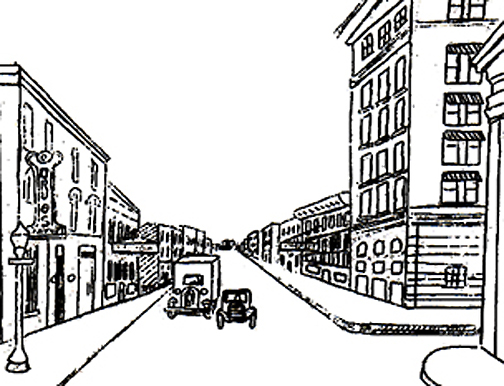The 53 seniors in Junior High School’s 1934 Civics class provided the information used in today’s column. The source is an impressive 25-page typewritten student project, “Know Our City,” part of the Pat Watson Collection at ETSU’s Archives of Appalachia.
The information is organized into four main sections – Historical Background, Beginnings of our City, Johnson City Today, A Forward Look – and 23 subsections. Also included are four hand-sketched illustrations: Henry Johnson, Main Street, Mayne Williams Public Library and Junior High School – drawn by three students.

Student artist shows what Main Street looked like in 1934 (viewed west to east)
The section titled “Education in Johnson City” begins: “The Johnson City public school system originated in 1864 when a log school house was built on Rome Hill (renamed Roan Hill).” The report went on to say that in 1866 the school was moved down upon Brush Creek near the old Camp Ground (W. Watauga). This building originally consisted of hewn logs, but was later weather boarded.
Two years later, a school building was erected on a hill at the newest Munsey Memorial Methodist Church annex on Roan Street. It became known as Science Hill (Male and Female Institute). This facility partially paid for by private subscriptions contained two classrooms downstairs and a large hall upstairs. Two more rooms were added in 1902.
About 1890, the school system was organized into a graded system with Science Hill School, Lusk School (SE corner of Roan and Watauga) and Langston High School. That same year, General John T. Wilder donated land for Martha Wilder School (on E. Myrtle Street), named in honor of his wife. Also that year, a four-room brick building was erected on a lot donated by Mrs. J. Allen Smith of Knoxville and named Columbus Powell in honor of her father. Two rooms were added in 1904 and four more plus a two-room basement in 1913.
About 1915, the old Science Hill School house was razed and a big new one was built in its location. Additions were made in 1921 and again in 1930. West Side School became a reality in 1907 followed by South Side in 1918, Junior High and North Side in 1922 and Keystone and Pine Grove in 1923. In 1930, new buildings were erected at Columbus Powell, Martha Wilder and West Side schools.
By 1934, the student report showed attendance at five black schools: Langston High (74), Langston Elementary (106), Dunbar (293), Douglas (86) and Roan Hill (35). Attendance at the 10 white ones were Science Hill (577), Junior High (1023), West Side (725), North Side (628), Columbus Powell (538), Martha Wilder (530), Keystone (415), South Side (381), Pine Grove (113) and Training School (272).
The handling of 5796 students required the services of 177 workers. That year 125 students graduated and the yearly per student cost was estimated to be $45. An organization known as the School Improvement Association held its first meeting in the downtown Christian Church by Miss Virginia Moore in 1910. This group soon became known as the Parent-Teachers Association with Mrs. L.D. Gump serving as president of the Martha Wilder PTA. Her counterpart at Columbus Power was Mrs. Harry W. Lyle.
Hats off to the 53 Junior High School Civic Class students for issuing this impressive document 72 years ago that helped preserve this area’s rich history. We are indebted to you. I will flaunt more of their extraordinary research in future columns.
